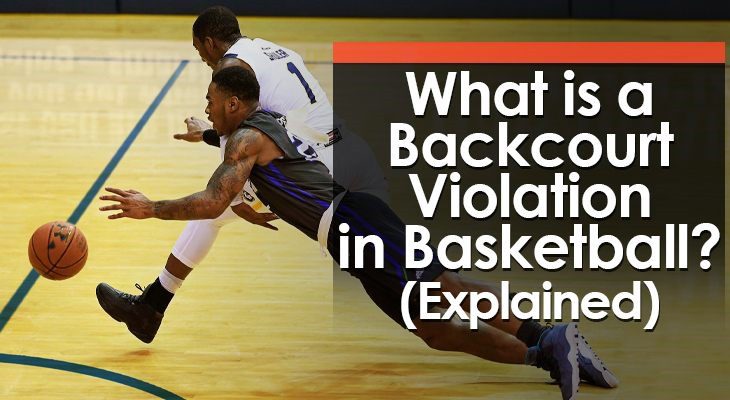
A backcourt violation in basketball can occur against against the offense two different ways, with both of them involving the half court line.
The line itself is easy to see and understand.
The turnovers that can be caused by it, however, are not…
Each of them has some subtle rules that can be confusing to fans, coaches, and players.
For that reason, this article will break down just what a backcourt violation in basketball is and how to coach your players to avoid them.
What Is a Backcourt Violation in Basketball?
There are two separate ways for the offense to commit a backcourt violation:
1. Not crossing the half court line within 10 seconds
Once inbounded, the offense has 10 seconds to advance the ball from the back court into the front court. This specific violation is called a 10-second violation.
2. The ball is dribbled or passed into the back court after the offense has possessed it in the front court
Once the ball has made it into the front court, the ball cannot be taken back into the back court by the offense unless it is deflected by the defense.
If any part of the ball or player holding the ball comes into contact with the half court line or back court, that is called an over and back violation.
Confusing Backcourt Violation Situations
There are two different circumstances that cause a lot of confusion for fans, players, coaches, and even referees at times revolving around the backcourt violation call.
1. The catch stops the count
The 10-second count does not end until the offense has possession in the front court.
Therefore the offense must actually CATCH the ball in the front court to avoid the violation, not just have it out of their hands in the back court.
2. Watch where you jump
Many times an offensive player will be getting trapped out high in the front court near the half court line and be looking to get rid of the ball.
Typically a trailing player will be the perfect potential reversal pass.
Or so they think.
But actually, if the trailing player jumps from the back court to catch the pass before landing, that is still an over and back violation because they never established position in the front court before catching the ball.
Teaching Players to Avoid Backcourt Violations
Hopefully the backcourt violation isn’t a huge challenge for your basketball team to overcome.
But it is still something that you can help your players quickly master with just a few easy tips:
a. Develop an inner clock
Unless your team uses a shot clock and can glance at where it’s at, your players will need to develop an inner clock to know when they’re in danger of not getting the ball across the half court line in time.
Typically, players always think 10 seconds is much shorter than it actually is.
Screaming fans and parents don’t tend to help with that.
So devote practice time to players advancing the ball to the front court with an audible count so they begin to realize what 10 seconds feels like.
b. Develop a solid press break
Typically defensive pressure will be the primary reason your team struggles with backcourt violations. So getting them into good positions against the pressure is very important.
Having them spaced out well and stressing that they must ADVANCE the ball on every catch are great principles to teach.
Implement my "1-4 press break" and you'll have no problem advancing the ball.
c. Stress the fundamentals
Spend a large amount of time dribbling, passing, and catching at your practices.
No matter how advanced your group is and how elementary these skills might seem, they can never get too good at them.
The ability to complete these 3 skills easily will result in your team having less trouble versus pressure.
And that means you won’t likely have to worry about backcourt violations as much either.

Frequently Asked Questions:
Why Is a Backcourt Violation Illegal?
The backcourt violation rule was put in the rulebook to give the offense less of an advantage.
The backcourt violation was instituted before the shot clock, so it gave trailing teams a better chance to get the ball back by having to guard a smaller area.
What’s the Penalty for a Backcourt Violation?
The penalty for a backcourt violation is a deadball turnover by the offense.
The defense will be granted possession on the sideline close to where the call was made.
Conclusion
A backcourt violation can occur in multiple ways.
But whether it’s a 10-second call or over and back, this mistake can generally be avoided.
Help your players become fundamentally sound.
Help your team get into an effective press break to avoid pressure.
And help your players learn just how long they have to get the ball across half court.
Do these things, and not only will your team not have to worry about a backcourt violation, but you’ll likely be a top-notch offensive team as well.
